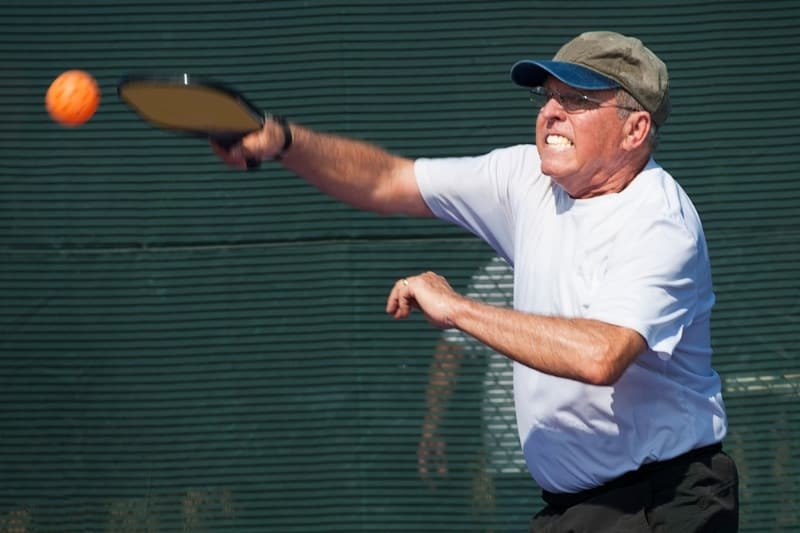
A big part of keeping pickleball fun and competitive is learning how to put away the points. But too often, rec players don’t attack enough or attack the wrong balls. If you want to level up and hone in on your offense skills, you need to know when and when NOT to attack in pickleball.
When To Attack In Pickleball
When Your Opponent Is Moving
The best time to attack in pickleball is when your opponents are out of position or moving. If you receive a short serve return, you will most likely be able to get to the ball faster than your opponent can to the kitchen. This is a great opportunity to drive at them or at their feet.
If you drive to their body, you will most likely get a weak block, a counter into the net, or for them to prop the ball up. If you’re able to aim at their moving feet, it will most likely end the point since it is difficult to return those shots.
When Your Opponent Or Opponents Are Far Back
If you and your partner are already at the non-volley zone and your opponents are back at the baseline or at the transition zone, you want to keep them back. If one of them is at the net and the other is kept back, continue to attack the player that is at the back. It is a lot more difficult to make good shots from the transition zone (no man’s land) or the baseline.
When you continue to attack the player kept at the back, you’re giving your opponent more chances to make an unforced error into the net. Or to prop up the ball where you or your partner can put away the point.
When Your Opponent Props Up The Ball
You should never miss an opportunity to smash away the ball when it is propped up to you. Whether you and your partner set yourself up for a pop up or whether your opponent has not honed in on their drops and dinks, you should take every opportunity to attack those attackable balls.
When You Want To Speed Up The Ball
When all four players are at the net, there will be a dinking battle until someone makes a move. This is where it is really important to know which balls to attack and when. At beginner and intermediate levels, someone will eventually make a dinking mistake into the net.
However, at intermediate to advanced levels, you should look for attack opportunities. You can either attack a dink that is a little too high or with enough pace that you can reach the ball before it bounces. However, if you choose to speed up the ball, you want to attack the player that is directly in front of you.
If you attack the player that is cross-court from you, the extra distance gives them more time to react. When you attack, make sure you’re always ready for a counter. Even if you think you have won a hand battle, do not let your guard down until the point is really over.
When NOT to attack in pickleball
When You’re Out Of Position
You’re out of position when you’re not in your stable, ready stance with your paddle in front of you. You could either be moving towards the net, pulled out wide from your partner, or in the transition zone (no man’s land). Your goal when you’re out of position is to get back to a stable, ready position at the non-volley zone.
You want to buy time so that you can get to the kitchen line. In order to do this, you want to reset the ball by dropping or dinking. You don’t want to be attacking your opponents who are already at the net when you’re midcourt. It is a lot easier for them to aim at your feet or counter your attacks when you’re in an awkward transition zone.
When Your Partner Is Out Of Position
Being in a ready position should always be your goal for both you and your partner. If your partner is stretched out wide to retrieve a ball, you should be covering for them. You don’t want to be attacking when your partner is away.
This leaves a huge area of the court for you to cover and for your opponents to place the ball where no one’s home. Instead, you would want to buy your partner time by dinking or dropping so that they can come back to their position.
When The Ball Is Not Attackable
Some players like to play aggressively, which means they will attack balls that are not attackable. A ball is not attackable when it has a low bounce with very little pace in the kitchen. A low bounce means a bounce with a maximum height generally below your knees. You don’t want to be impatient and attack a ball into the net.
Attacking Without Purpose
As mentioned earlier, some players’ preference is to play offensive most of the time. Which can mean that they’re attacking balls without considering a counter-attack, where they and their partner are positioned in the court, and whether it is the right ball to attack.
You may have heard that in pickleball, there is a saying that goes,
Placement over power.
You don’t want to attack balls for the sake of attacking. And you don’t necessarily need to hit the ball with a lot of power in order to attack. You want to be mindful and intentional about each attack. That is what separates players in each level.
More Pickleball Tips
Learning when to attack in pickleball and when not to is an important skill to level up. While a lot of it can be understood in context, drilling will help cement them into practice. Drilling net games such as “dink, dink, attack” with a few fellow pickleball enthusiasts will help everyone get better at their attack games. Even if you don’t have an available court, grab a portable net like the one below and start drilling.

Read Next: Pickleball Strategy For Doubles
Read Also: How To Be A Good Pickleball Partner

